Detection of Aircraft Touchdown Using Longitudinal Acceleration and Continuous Wavelet Transformation
Abstract
1. Introduction
2. The Idea of a Touch-Down Virtual Sensing
2.1. Genesis
- ax, ay, az accelerations; sampling frequency 50 Hz,
- angular rates p, q, r; sampling frequency 50 Hz,
- Euler angles Φ, Θ, Ψ, sampling frequency 50 Hz,
- static pressure inside the non-pressurised cockpit ps; sampling frequency 10 Hz
- navigation data ϕGPS, λGPS, HGPS, TT, GS (latitude, longitude, altitude, true track, and ground speed); sampling frequency 10 Hz,
- Global Positioning System (GPS) time; sampling frequency 10 Hz.
2.2. Continuous Wavelet Transformation (CWT)
2.3. Proposed Method and Algorithm
3. Verification of the Methodology
3.1. Testing Platform
- PCDA-01 air data computer;
- satellite navigation receiver PCGP-01;
- PCIM-01 inertial measurement system.
3.2. Selection and Accuracy of the MEMS Sensors Used
- 0.0019 and 0.0052 for I-31T measurement system (sampling frequency of 50 Hz),
- 0.0028 and 0.0041 for PCIM-01 inertial measurement unit (sampling frequency of 1000 Hz).
3.3. Analysis of Sample Data
4. Conclusions
Author Contributions
Funding
Conflicts of Interest
Abbreviations
| Θ | pitch Euler angle (deg); |
| Φ | roll Euler angle (deg); |
| Ψ | yaw Euler angle (deg); |
| GPS longitude (deg); | |
| GPS latitude (deg); | |
| σn | standard deviation of virtual signal noise; |
| Fourier transform of ; | |
| mother wavelet; | |
| basic wavelet; | |
| scale factor; | |
| longitudinal acceleration related to g0; | |
| lateral acceleration related to g0; | |
| vertical acceleration related to g0; | |
| A | virtual signal peak |
| wavelet shift; | |
| generic function; | |
| fs | sampling time (s); |
| g0 | standard acceleration due to gravity (9.80665 m·s−2); |
| ground speed (m·s−1); | |
| GPS altitude (m); | |
| indicated airspeed (m·s−1); | |
| roll angular velocity (deg s−1); | |
| static atmospheric pressure (Pa); | |
| pitch angular velocity (deg s−1); | |
| yaw angular velocity (deg s−1); | |
| SNR | signal to noise ratio; |
| time (s); | |
| true airspeed (m·s−1); | |
| true track (m·s−1); | |
| VS | vertical speed (m·s−1); |
References
- Soares, P.F.M. Flight Data Monitoring and its Application on Algorithms for Precursor Detection. Master’s Thesis, Instituto Superior Técnico Lisbon, Lisbon, Portugal, 2014. [Google Scholar]
- Masiulionis, T.; Stankūnas, J. Review of equipment of flight analysis and development of interactive aeronautical chart using Google Earth’s software. Transport 2017, 33, 580–588. [Google Scholar] [CrossRef]
- Pytka, J.; Budzyński, P.; Łyszczyk, T.; Józwik, J.; Michałowska, J.; Tofil, A.; Błażejczak, D.; Laskowski, J. Determining Wheel Forces and Moments on Aircraft Landing Gear with a Dynamometer Sensor. Sensors 2019, 20, 227. [Google Scholar] [CrossRef] [PubMed]
- Pytka, J.; Budzyński, P.; Józwik, J.; Michałowska, J.; Tofil, A.; Łyszczyk, T.; Błażejczak, D. Application of GNSS/INS and an Optical Sensor for Determining Airplane Takeoff and Landing Performance on a Grassy Airfield. Sensors 2019, 19, 5492. [Google Scholar] [CrossRef] [PubMed]
- Pieniazek, J. Vision based airplane localization for automatic approach. In Proceedings of the 2017 IEEE International Workshop on Metrology for AeroSpace (MetroAeroSpace), Padua, Italy, 21–23 June 2017; pp. 424–427. [Google Scholar] [CrossRef]
- Luong, Q.V.; Jang, D.-S.; Hwang, J. Intelligent Control Based on a Neural Network for Aircraft Landing Gear with a Magnetorheological Damper in Different Landing Scenarios. Appl. Sci. 2020, 10, 5962. [Google Scholar] [CrossRef]
- De Rivals, G. Landing Trajectory Computation. In Proceedings of the EOFDM 3rd Conference, Cologne, Germany, 6 February 2014. [Google Scholar]
- Hirsenkorn, N.; Hanke, T.; Rauch, A.; Dehlink, B.; Rasshofer, R.; Biebl, E. Virtual sensor models for real-time applications. Adv. Radio Sci. 2016, 14, 31–37. [Google Scholar] [CrossRef][Green Version]
- Inamdar, S.; Allemang, R.J.; Phillips, A.W. Estimation of Frequency and Damping of a Rotating System Using MEOT and Virtual Sensor Concept. Special Topics in Structural Dynamics 2016; Springer: Berlin, Germany, 2016; Volume 6, pp. 23–35. [Google Scholar]
- Dolega, B.; Kopecki, G.; Tomczyk, A. Possibilities of using software redundancy in low cost aeronautical control systems. In Proceedings of the 2016 IEEE Metrology for Aerospace (MetroAeroSpace), Florence, Italy, 22–23 June 2016; pp. 33–37. [Google Scholar] [CrossRef]
- Piwek, K.; Wiśniowski, W. Small air transport aircraft entry requirements evoked by FlightPath 2050. Aircr. Eng. Aerosp. Technol. 2016, 88, 341–347. [Google Scholar] [CrossRef]
- Bakunowicz, J.; Rzucidło, P. Measurement and analysis of standard flight parameters based on MEMS sensors. J. Sens. Sens. Syst. 2017, 6, 211–222. [Google Scholar] [CrossRef]
- Szpunar, R.; Rzucidło, P. Application of ASG-EUPOS network for on-board control system of a small unmanned aircraft. Prz. Elektrotech. 2012, 88, 154–158. [Google Scholar]
- Rzucidlo, P.; Kopecki, G.H.; DeGroot, K.; Kucaba-Pietal, A.; Smusz, R.; Szewczyk, M.; Szumski, M. Data acquisition system for PW-6U in flight boundary layer mapping. Aircr. Eng. Aerosp. Technol. 2016, 88, 572–579. [Google Scholar] [CrossRef]
- Kopecki, G.H.; Rzucidlo, P. Integration of optical measurement methods with flight parameter measurement systems. Meas. Sci. Technol. 2016, 27, 054003. [Google Scholar] [CrossRef]
- Boden, F.; de Groot, K.; Meyer, J.; Meyer, R.; Bakunowicz, J.; Rzucidło, P.; Smusz, R.; Szewczyk, M.; Szumski, M. Flow and Structure Deformation Research of a Composite Glider in Flight Conditions. In Proceedings of the 46th Society of Flight Test Engineers International Symposium Breaking Barriers, Lancaster, CA, USA, 14−18 September 2015. [Google Scholar]
- Adamcik, F. Error analysis of the inertial measurement unit/inercinio matavimų bloko klaidų analizė. Aviation 2011, 15, 5–10. [Google Scholar] [CrossRef]
- Goupillaud, P.; Grossmann, A.; Morlet, J. Cycle-octave and related transforms in seismic signal analysis. Geoexploration 1984, 23, 85–102. [Google Scholar] [CrossRef]
- Dziedziech, K.; Staszewski, W.J.; Uhl, T. Wavelet-Based Frequency Response Function: Comparative Study of Input Excitation. Shock. Vib. 2014, 2014, 502762. [Google Scholar] [CrossRef]
- Torrence, C.; Compo, G.P. A practical guide to wavelet analysis. Bull. Am. Meteorol. Soc. 1998, 79, 61–78. [Google Scholar] [CrossRef]
- Bentz, C.M.; Baudzus, L.; Krummrich, P.M. Signal to Noise Ratio (SNR) Enhancement Comparison of Impulse-, Coding- and Novel Linear-Frequency-Chirp-Based Optical Time Domain Reflectometry (OTDR) for Passive Optical Network (PON) Monitoring Based on Unique Combinations of Wavelength Selective Mirrors. Photonics 2014, 1, 33–46. [Google Scholar] [CrossRef]
- Basmadji, F.; Gruszecki, J.; Kordos, D.; Rzucidlo, P. Development of ground station for a terrain observer-hardware in the loop simulations. In Proceedings of the AIAA Modeling and Simulation Technologies Conference, Minneapolis, MN, USA, 13−16 August 2012. [Google Scholar]
- Grzybowski, P.; Klimczuk, M.; Rzucidlo, P. Distributed measurement system based on CAN data bus. Aircr. Eng. Aerosp. Technol. 2018, 90, 1249–1258. [Google Scholar] [CrossRef]
- Stock, M. CANaerospace-Interface Specification for Airborne CAN Applications V 1.7; Stock Flight Systems: Berg/Farchach, Germany, 2006; p. 12. [Google Scholar]
- Rzucidlo, P. Monitoring and data acquisition system for experimental general aviation fly-by-wire aircraft. Aviation 2006, 10, 16–20. [Google Scholar] [CrossRef]
- Guerrier, S.; Skaloud, J.; Stebler, Y.; Victoria-Feser, M.-P. Wavelet-Variance-Based Estimation for Composite Stochastic Processes. J. Am. Stat. Assoc. 2013, 108, 1021–1030. [Google Scholar] [CrossRef] [PubMed]
- Boden, F.; Lawson, N.; James, W.; Tatam, R.P. Special feature on Advanced ln-flight Measurement Techniques AIM2. Meas. Sci. Technol. 2017, 28, 1–2. [Google Scholar] [CrossRef]
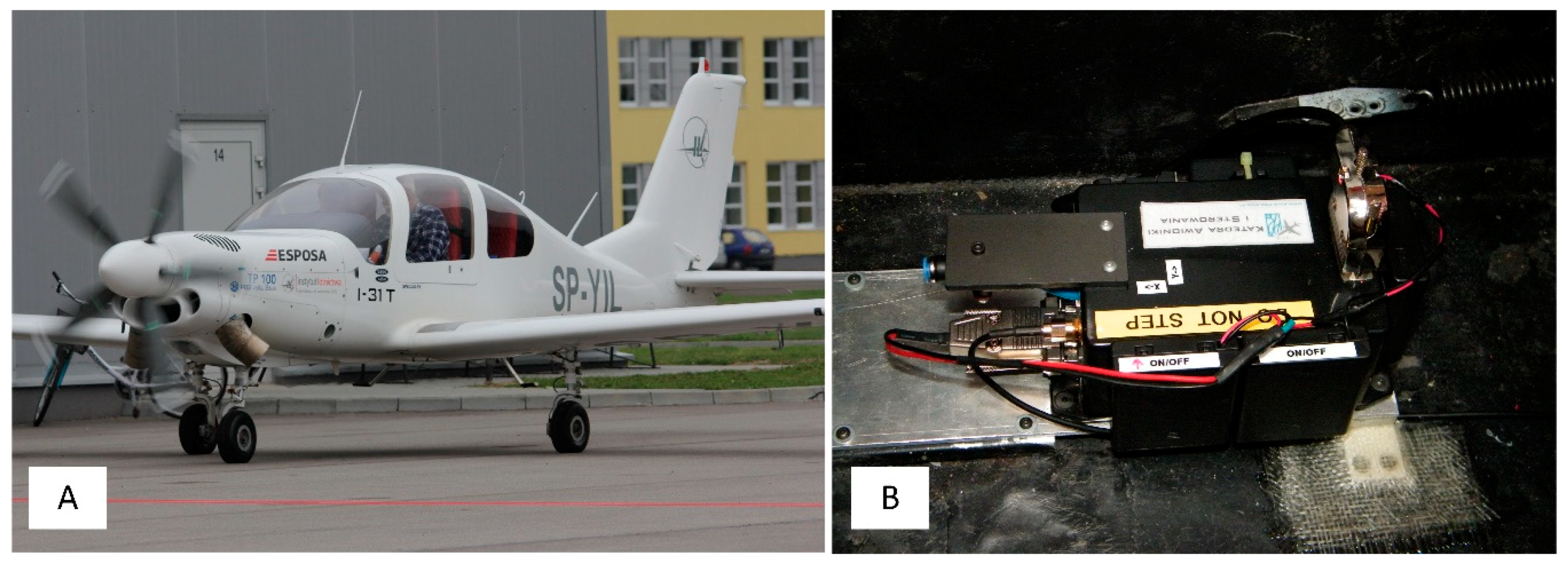
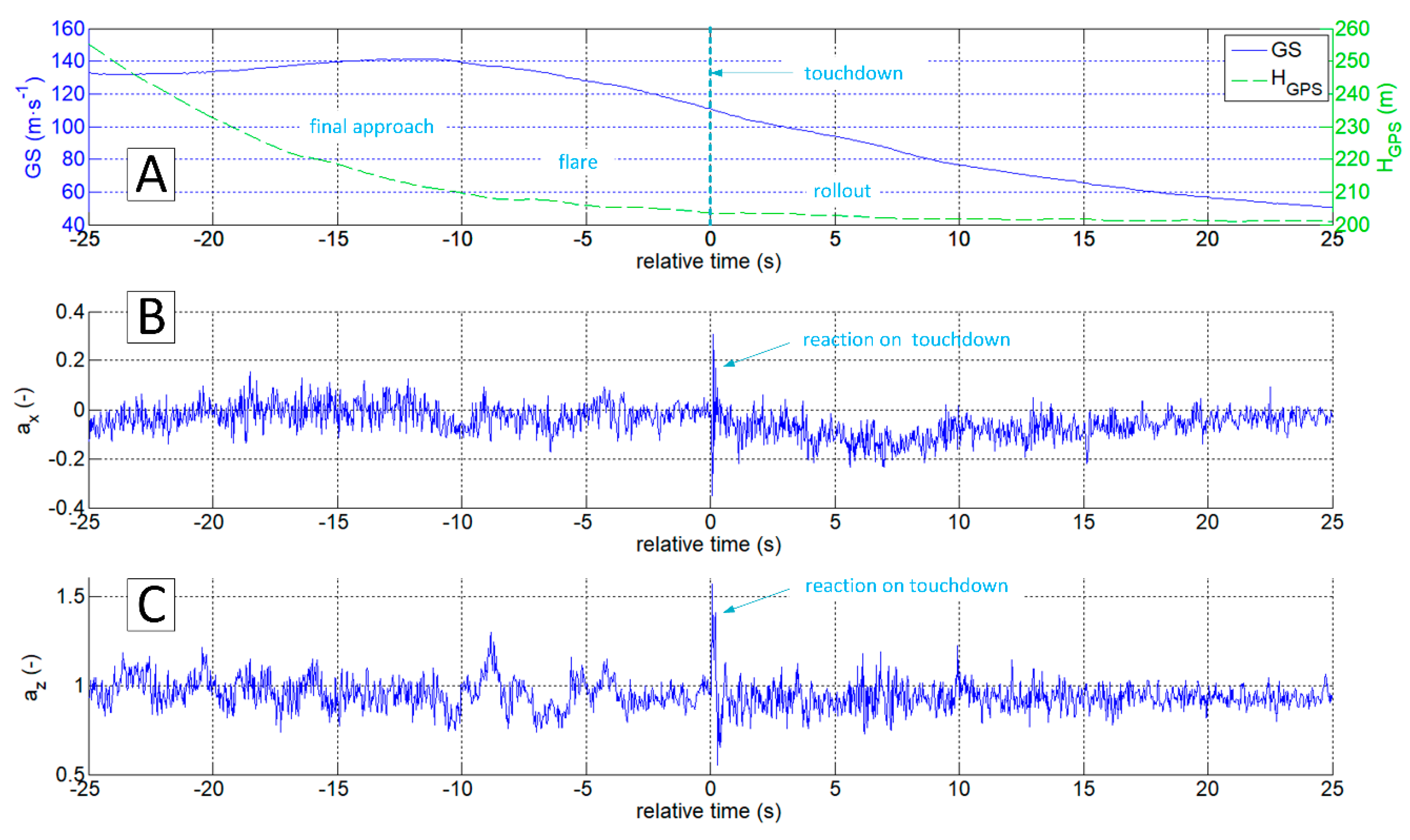
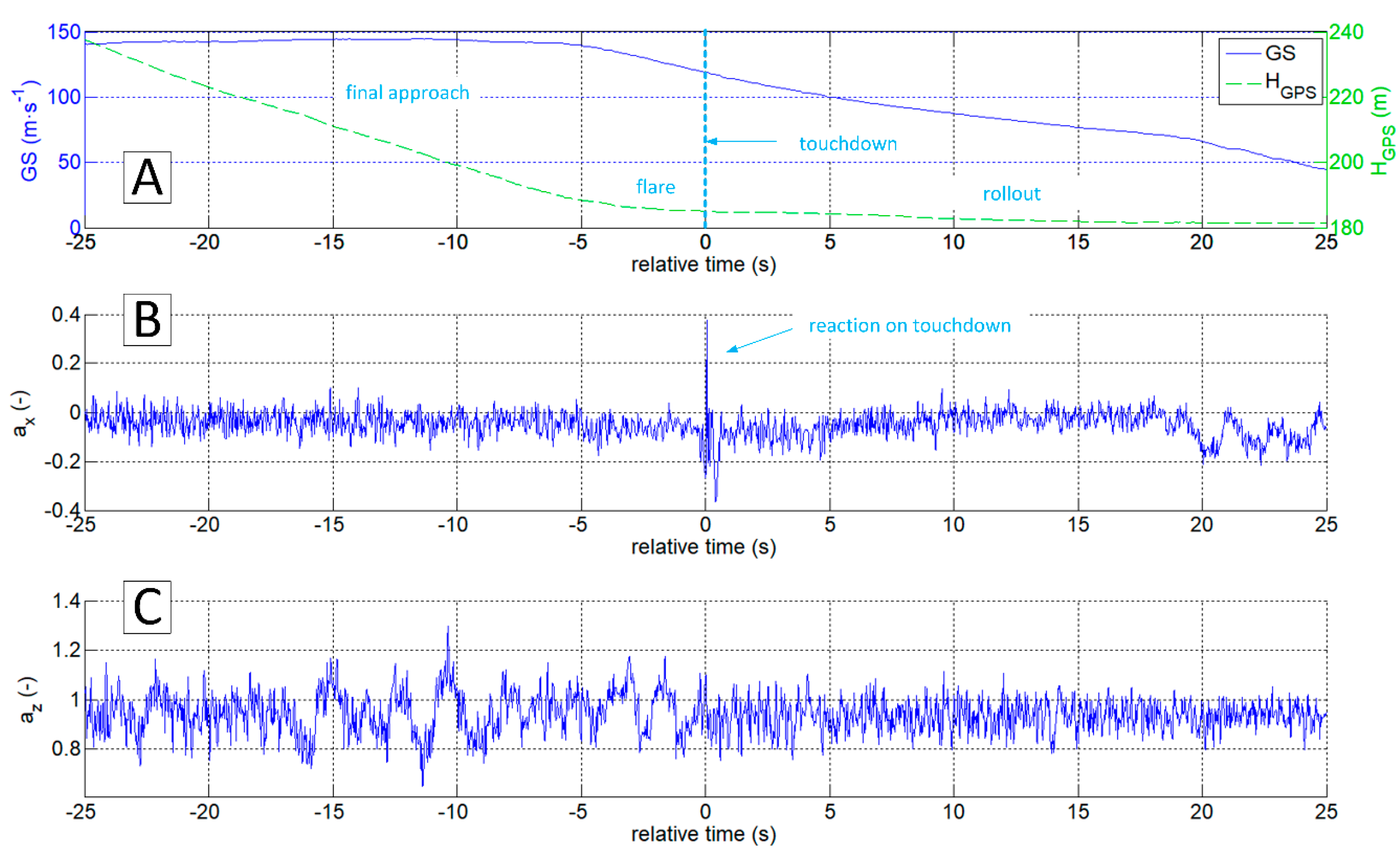
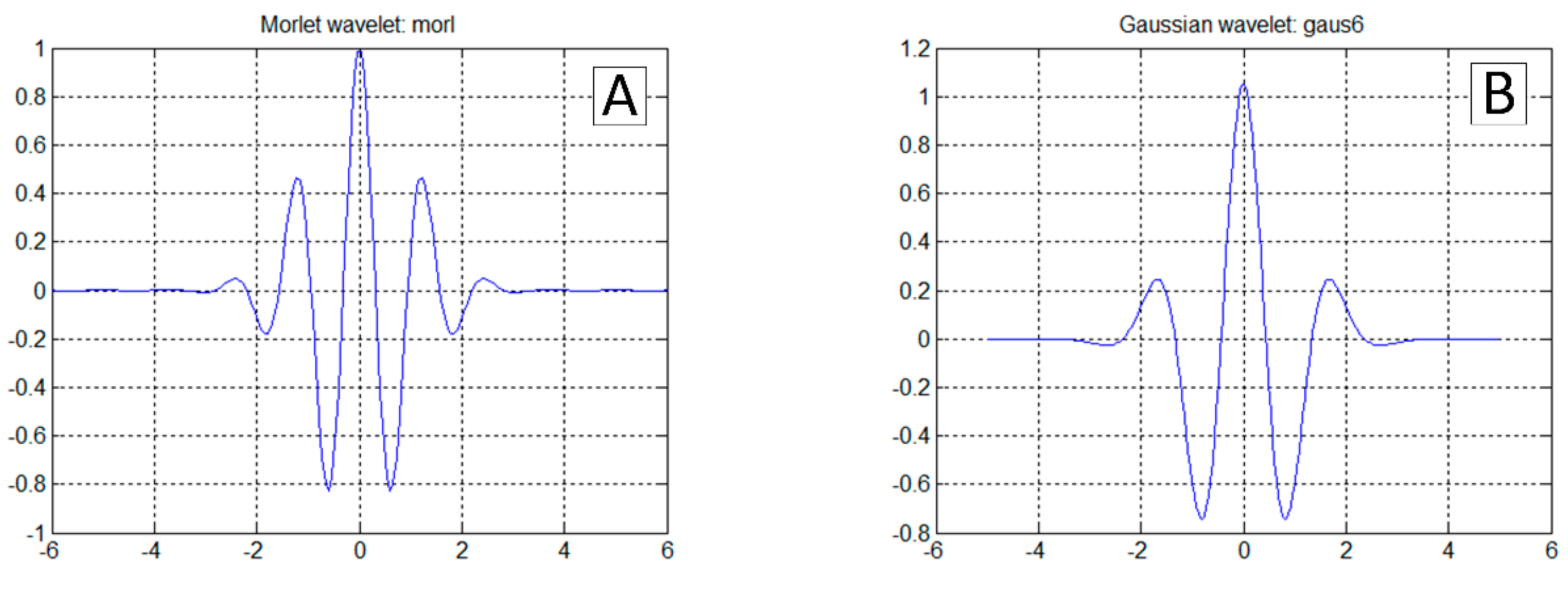

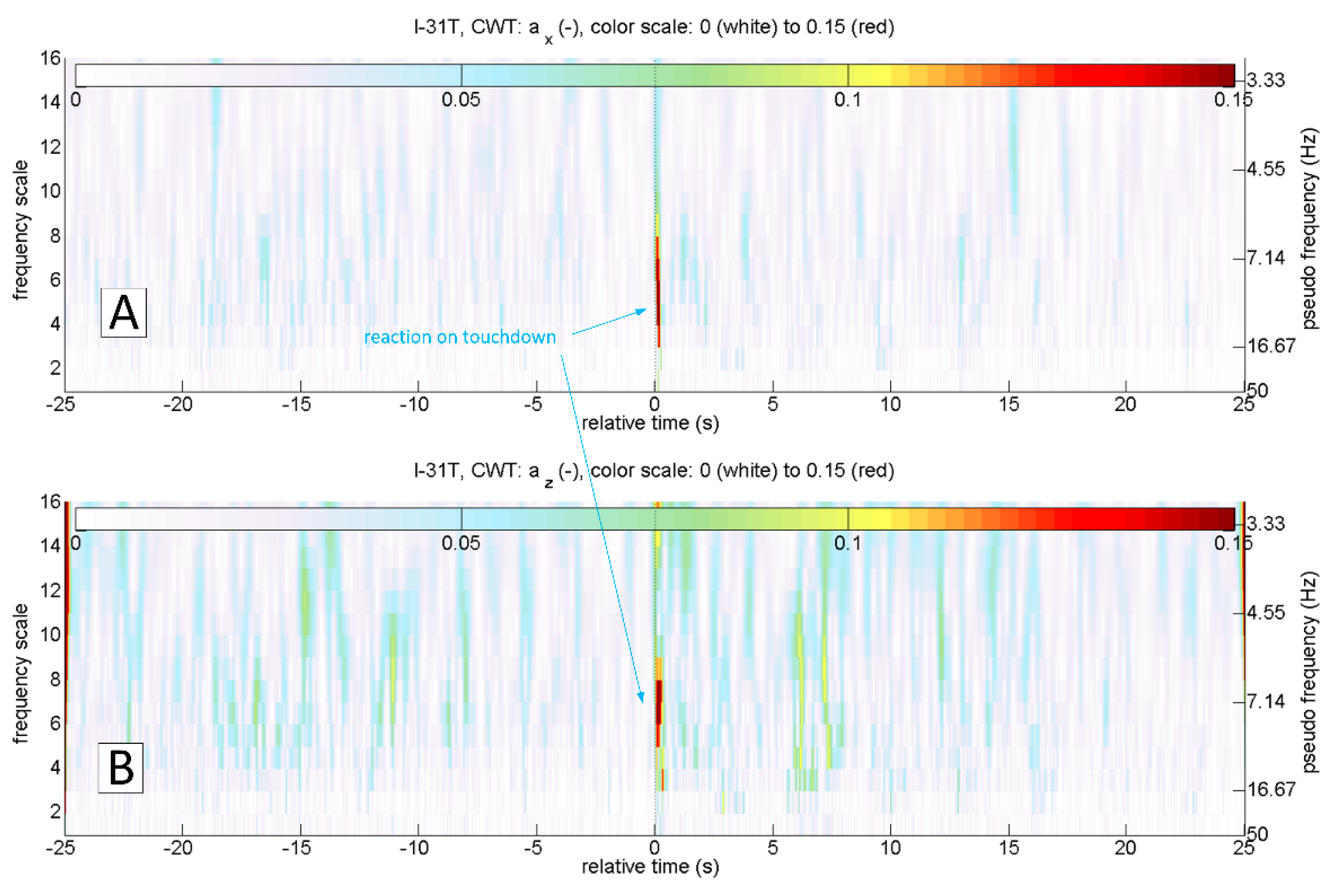
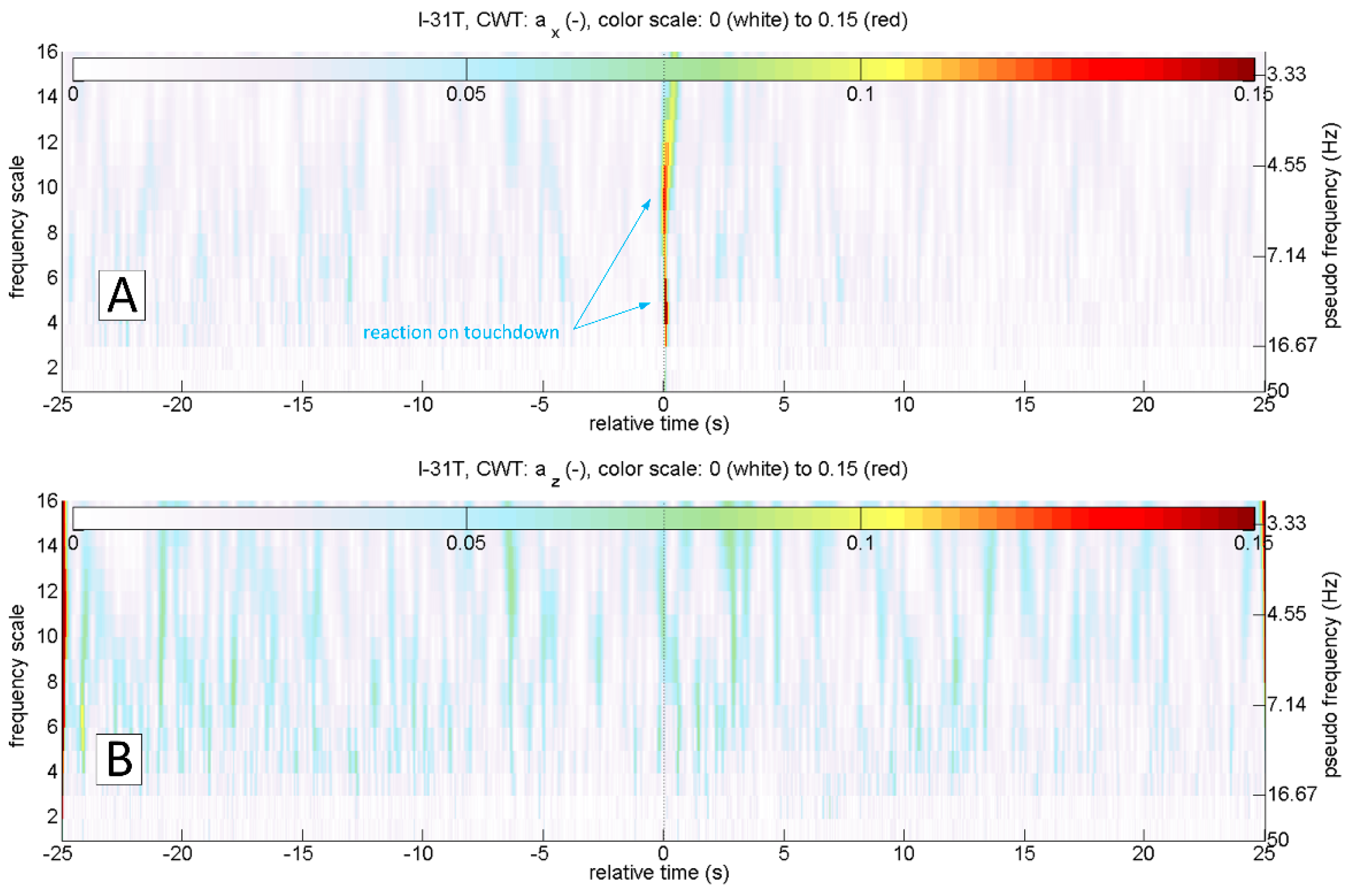

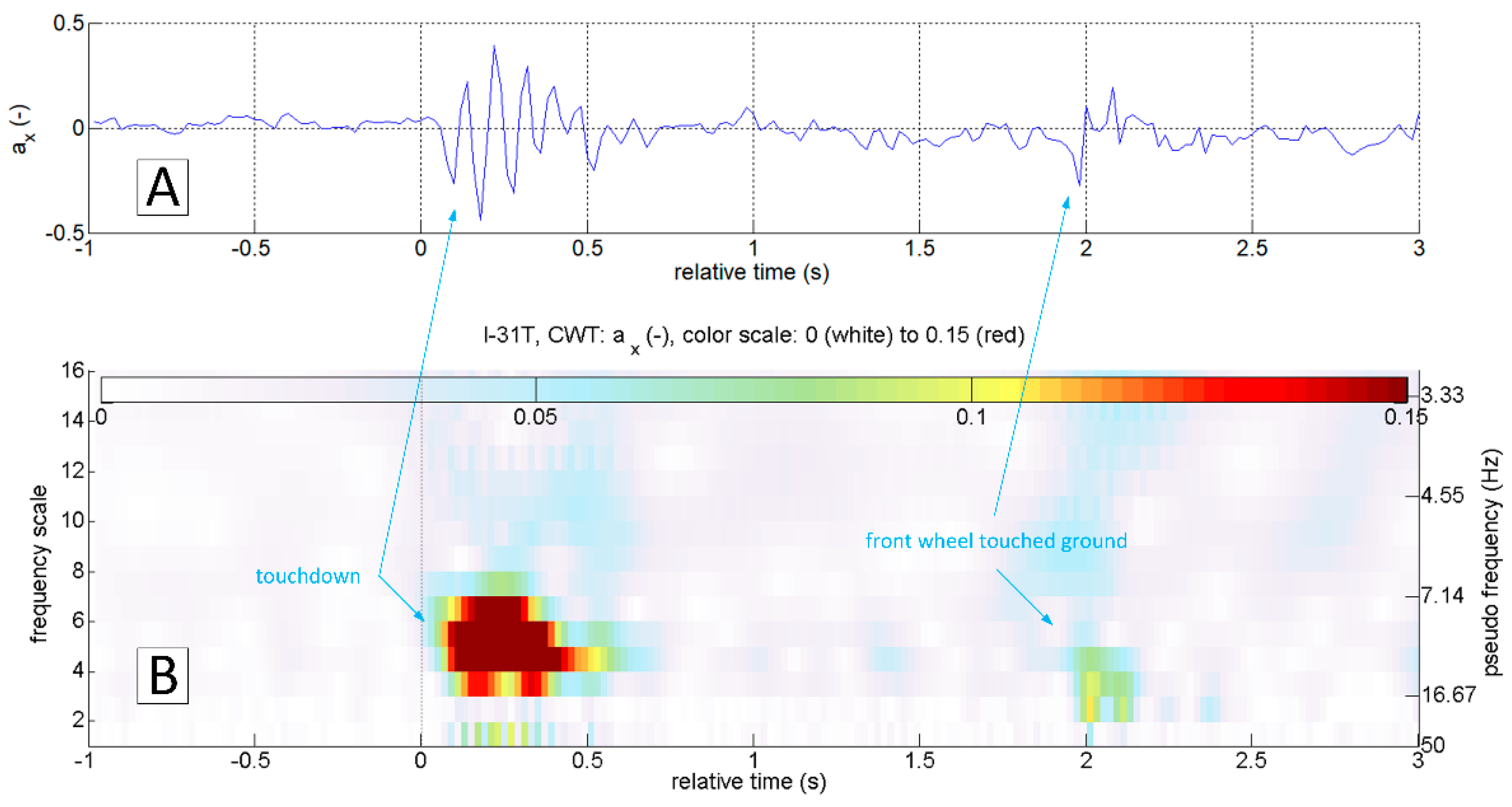
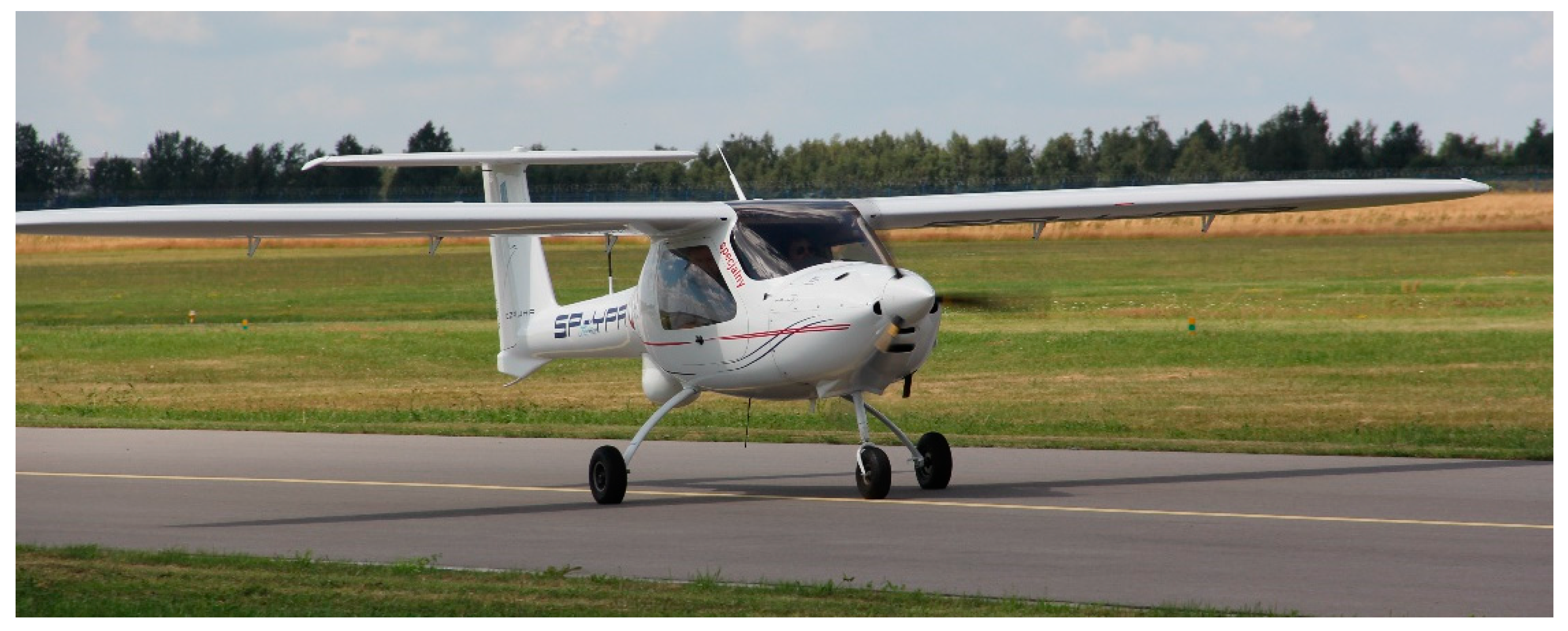




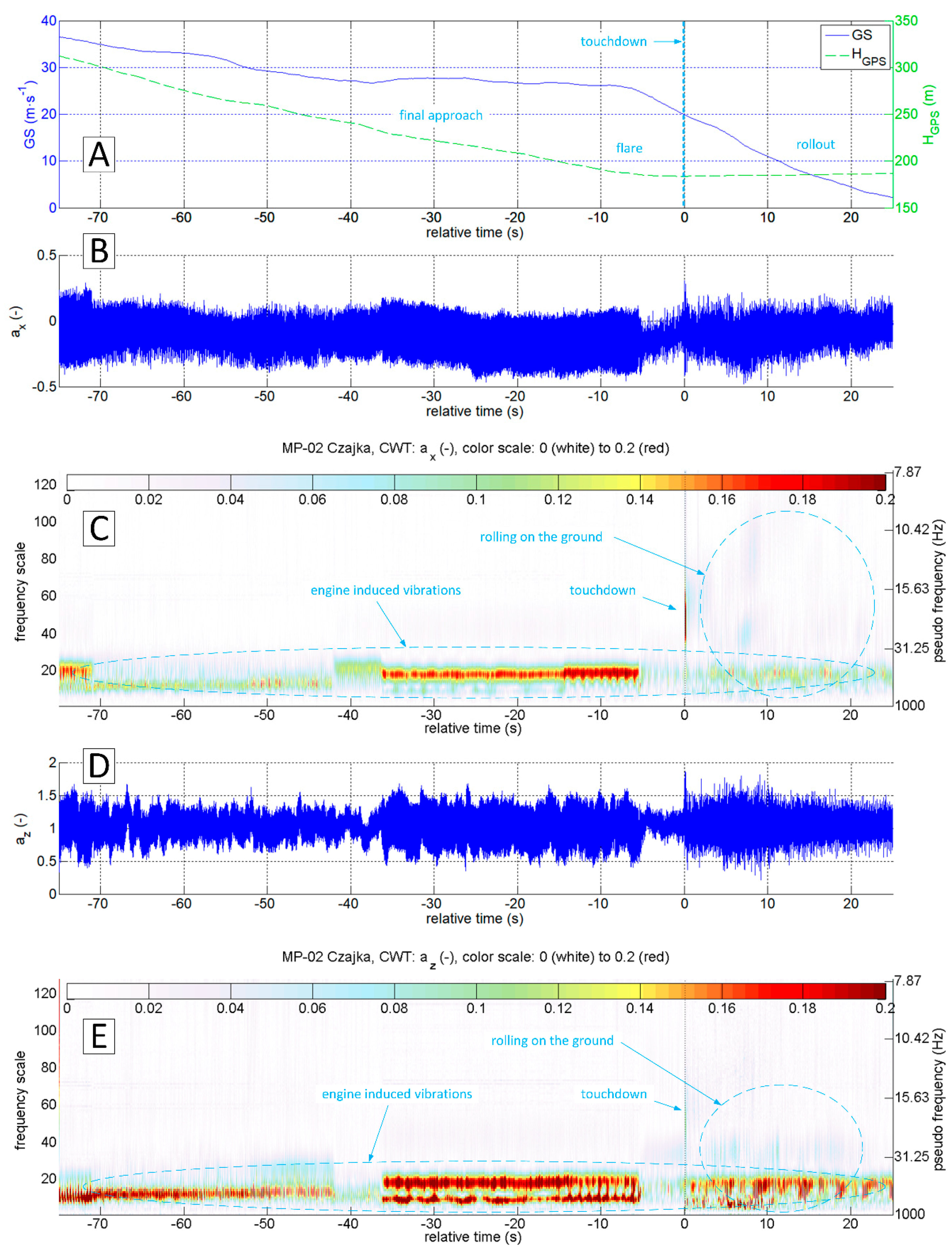
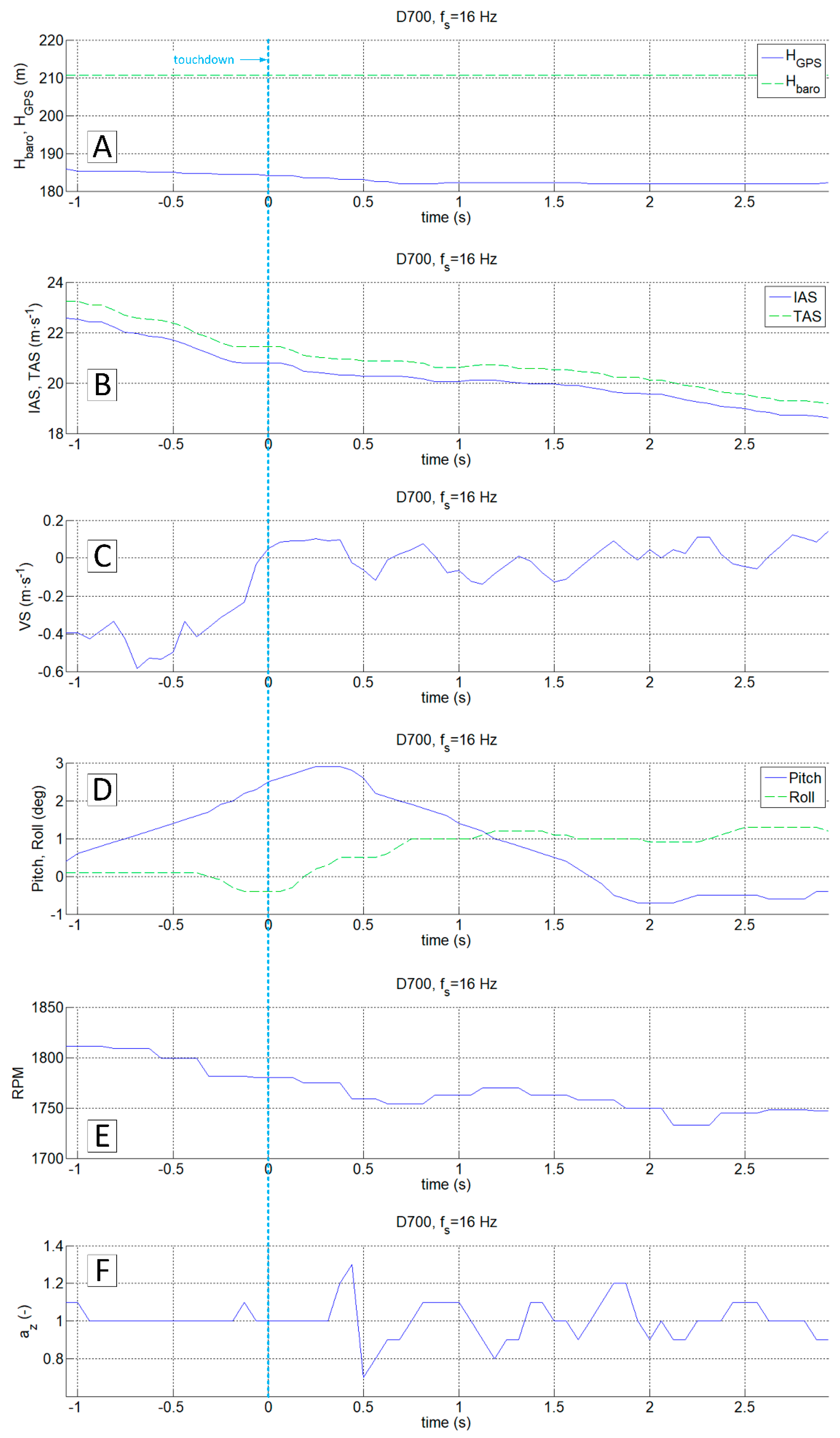
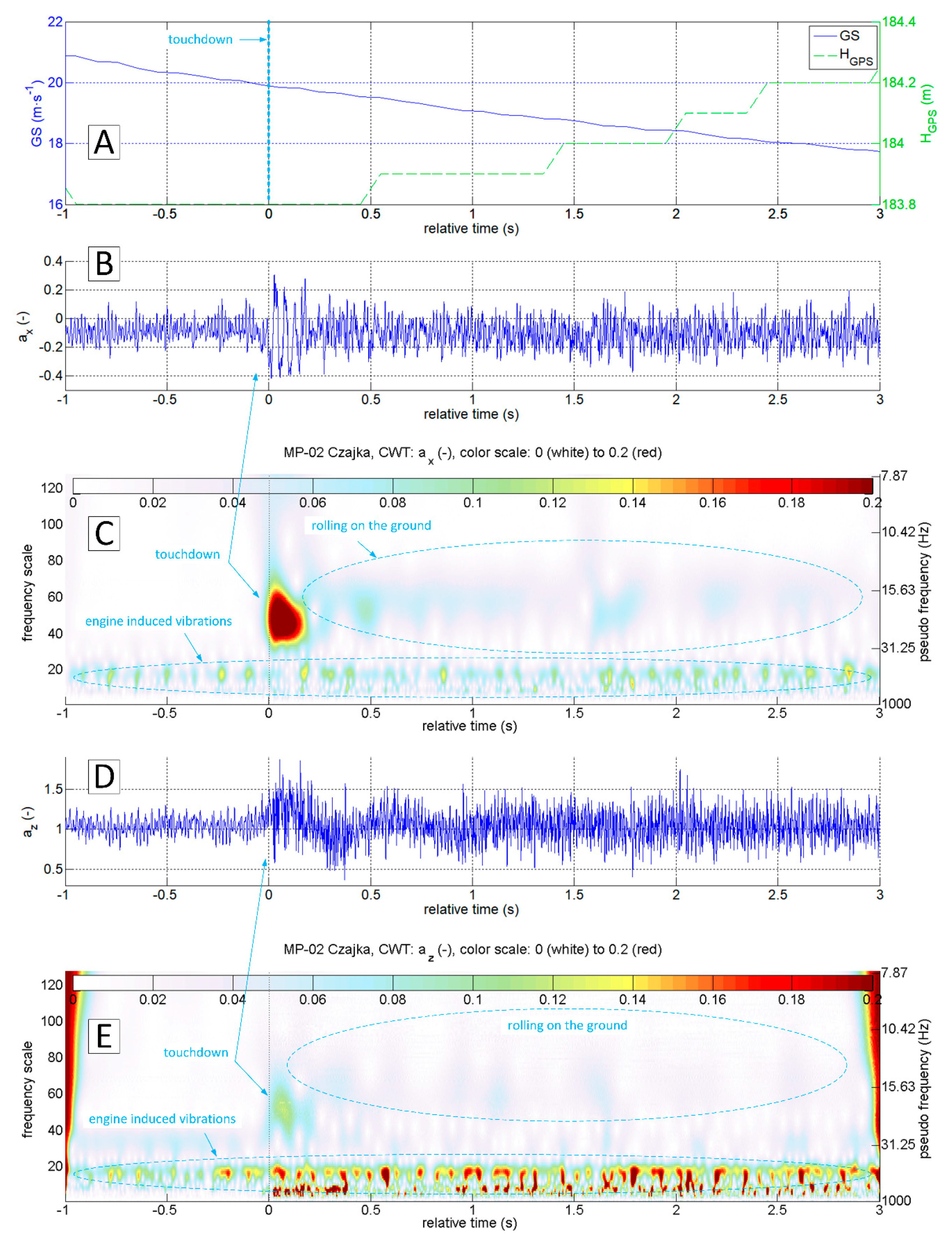

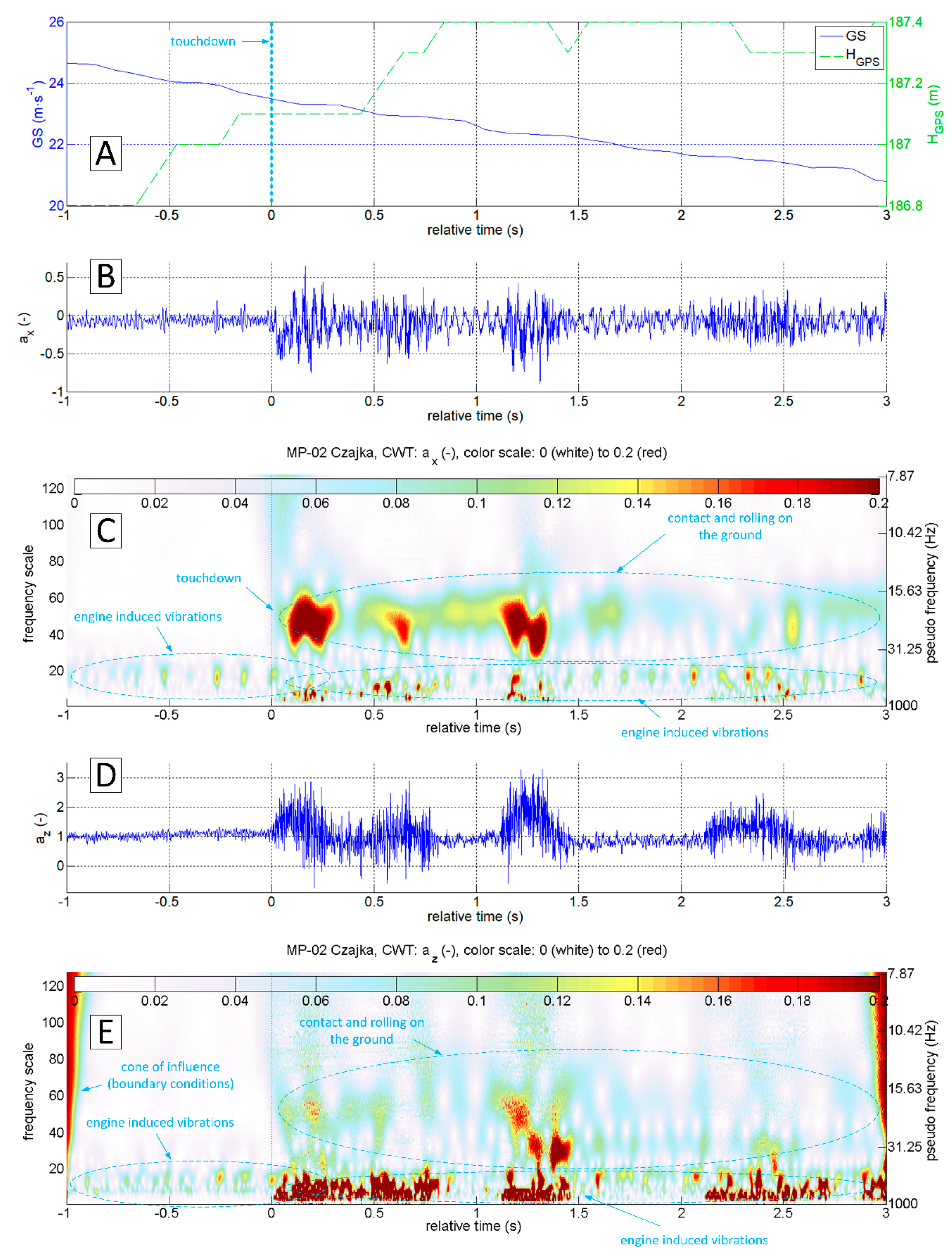

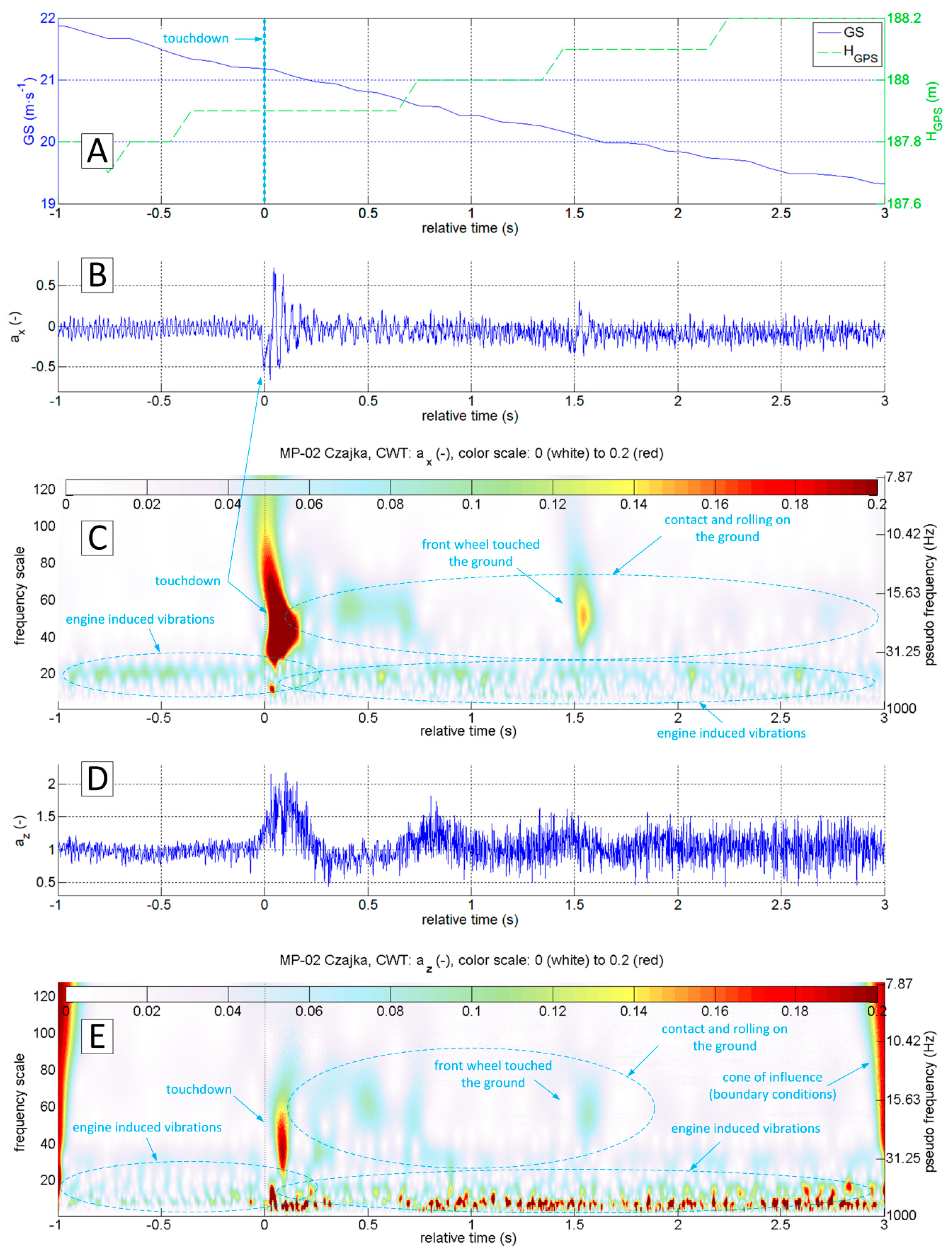


| No. | Landing of MP-02 (GPS Time) | Max. Value of CWT Coeff. (Freq. Scale) | VSig1 Peak /Delay | VSig2 Peak /Delay | VSig3 Peak /Delay | Remarks |
|---|---|---|---|---|---|---|
| 1 | 17 May 2017 #1 10:48:31.9 | 0.60 (255) | 2.58/0.09 s | 4.34/0.07 s | 3.41/0.06 s | T&G, concrete 26 EPRJ |
| 2 | 17 May 2017 #2 10:54:21 | 0.30 (55) | 1.45/0.05 s | 2.49/0.05 s | 2.02/0.05 s | T&G, concrete 26 EPRJ |
| 3 | 17 May 2017 #3 11:00:39.7 | 0.20 (249) | 1.04/0.10 s | 1.86/0.09 s | 1.18/0.07 s | T&G, grass 26 EPRJ |
| 4 | 17 May 2017 #4 11:05:14.5 | 0.20 (255) | 0.93/0.08 s | 2.75/0.06 s | 2.24/0.06 s | T&G, concrete 26 EPRJ |
| 5 | 12 July 2017 #1 11:59:46.7 | 0.70 (24) | 0.84/0.09 s | 0.32/0.09 s | 0.85/0.09 s | T&G, concrete 26 * EPRJ |
| 6 | 12 July 2017 #2 12:05:15.9 | 0.45 (184) | 2.02/0.04 s | 3.79/0.05 s | 3.02/0.00 s | T&G, concrete 26 EPRJ |
| 7 | 12 July 2017 #3 12:10:50.2 | 0.32 (255) | 1.32/0.16 s | 2.25/0.10 s | 1.84/0.39 s | T&G, grass 26 EPRJ |
| 8 | 12 July 2017 #4 12:16:13.5 | 0.27 (140) | 1.15/0.05 s | 1.82/0.00 s | 1.46/0.00 s | LDG, concrete 26 EPRJ |
| 9 | 12 July 2017 #5 13:23:22.2 | 0.18 (254) | 0.88/0.04 s | 1.60/0.04 s | 1.38/0.00 s | T&G, concrete 26 EPRJ |
| 10 | 12 July 2017 #6 13:53:26.3 | 0.25 (56) | 1.13/0.03 s | 1.74/0.02 s | 1.57/0.03 s | LDG, concrete 26 EPRJ |
| 11 | 24 November 2017 #1 12:28:13.1 | 0.22 (100) | 1.14/0.06 s | 2.07/0.05 s | 1.24/0.06 s | T&G, grass 26 EPRJ |
| 12 | 24 November 2017 #2 12:33:41.4 | 0.22 (50) | 1.40/0.01 s | 3.58/0.09 s | 2.99/0.09 s | T&G, grass 26 EPRJ |
| 13 | 24 November 2017 #3 12:39:29.9 | 0.18 (235) | 0.81/0.02 s | 3.59/0.04 s | 2.72/0.04 s | T&G, grass 26 EPRJ |
| 14 | 24 Nov 2017 #4 12:45:05.7 | 0.35 (48) | 1.48/0.05 s | 2.41/0.09 s | 1.94/0.09 s | T&G, grass 26 EPRJ |
| 15 | 24th November 2017 #5 12:50:52.1 | 0.21 (30) | 0.95/0.09 s | 1.74/0.07 s | 1.51/0.02 s | T&G, grass 26 EPRJ |
| 16 | 24 November 2017 #6 12:55:19.6 | 0.24 (40) | 1.02/0.04 s | 1.92/0.02 s | 1.54/0.02 s | LDG, concrete 26 EPRJ |
| 17 | 11 May 2018 #1 08:42:58.3 | 0.30 (56) | 1.30/0.03 s | 2.15/0.02 s | 1.72/0.02 s | T&G, concrete 08 EPRJ |
| 18 | 11 May 2018 #2 08:48:13.3 | 0.35 (52) | 1.4/0.03 s | 2.19/0.02 s | 1.74/0.04 s | T&G, concrete 26 EPRJ |
| 19 | 11 May 2018 #3 09:10:05.3 | 0.25 (52) | 1.25/0.01 s | 1.65/0.01 s | 1.63/0.01 s | LDG, Laszki 77 |
| 20 | 27 July 2018 #1 14:56:53.6 | 0.70 (256) | 2.70/0.02 s | 4.92/0.01 s | 3.89/0.01 s | T&G, concrete 08 EPRJ |
| 21 | 27 July 2018 #2 15:02:11.9 | 0.55 (256) | 2.40/0.04 s | 4.71/0.02 s | 3.59/0.04 s | T&G, concrete 08 EPRJ |
| 22 | 27 July 2018 #3 15:07:12.1 | 0.30 (108) | 1.35/0.07 s | 2.36/0.03 s | 1.72/0.04 s | LDG, concrete 08 EPRJ |
Publisher’s Note: MDPI stays neutral with regard to jurisdictional claims in published maps and institutional affiliations. |
© 2020 by the authors. Licensee MDPI, Basel, Switzerland. This article is an open access article distributed under the terms and conditions of the Creative Commons Attribution (CC BY) license (http://creativecommons.org/licenses/by/4.0/).
Share and Cite
Bakunowicz, J.; Rzucidło, P. Detection of Aircraft Touchdown Using Longitudinal Acceleration and Continuous Wavelet Transformation. Sensors 2020, 20, 7231. https://doi.org/10.3390/s20247231
Bakunowicz J, Rzucidło P. Detection of Aircraft Touchdown Using Longitudinal Acceleration and Continuous Wavelet Transformation. Sensors. 2020; 20(24):7231. https://doi.org/10.3390/s20247231
Chicago/Turabian StyleBakunowicz, Jerzy, and Paweł Rzucidło. 2020. "Detection of Aircraft Touchdown Using Longitudinal Acceleration and Continuous Wavelet Transformation" Sensors 20, no. 24: 7231. https://doi.org/10.3390/s20247231
APA StyleBakunowicz, J., & Rzucidło, P. (2020). Detection of Aircraft Touchdown Using Longitudinal Acceleration and Continuous Wavelet Transformation. Sensors, 20(24), 7231. https://doi.org/10.3390/s20247231






